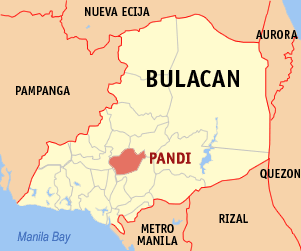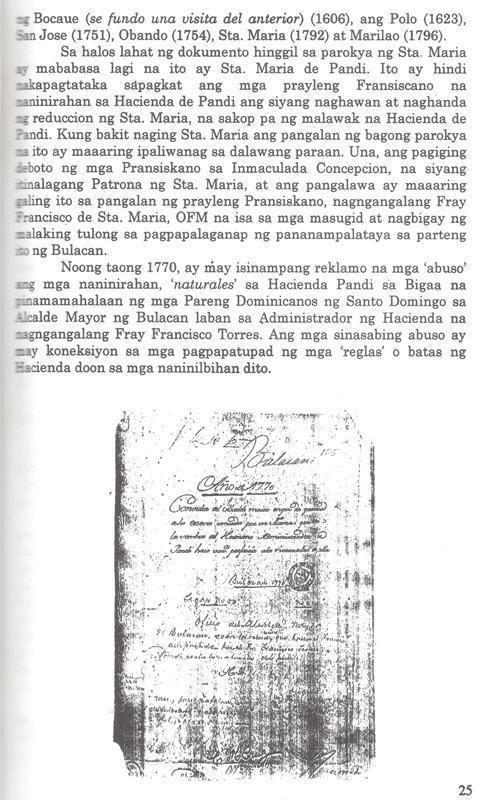Pandi is a second class rural municipality in the province of Bulacan, Philippines. The municipality of Pandi lies 41 kilometres (25 miles) north-east of Manila and is located at the eastern portion of Bulacan Province. According to the 2015 census, it has a population of 89,075 inhabitants.
With the continous expansion of Metro Manila, Pandi is now included in the Greater Manila's build-up which reaches San Ildenfonso, Bulacan at its northernmost part. Pandi is one of the youngest towns in Bulacan, During the Spanish Regime, Pandi was a part of the political jurisdiction of the town of Meycauyan City including the tows of San Jose del Monte, Bocaue, Marilao, Valenzuela, Obando,Santa Maria, Balagtas, it also formed part of the vast Hacienda Santa Maria de Pandi, which included the towns of Sta. Maria and Balagtas and parts of Angat and Bustos. Pandi was then a part of the town of Balagtas (then Bigaa) until its formal separation and independence on April 17, 1946.
Early History
Pandi was originally part of the Hacienda of Dominicans named Hacienda which belongs to the Town Santa Maria de Pandi (now Santa Maria, Bulacan). In 1874 it was turn over to the town of Bigaa as one of its Barrio and the religious activity belongs to Convento de Bigaa under the auspices of Augustinian order established a chapel under the advocacy of Immaculate Concepcion.
Republic of Kakarong de Sili.
During the Philippine Revolution, Pandi played a vital and historical role in the fight of Philippine independence, Pandi is historically known for the Real de Kakarong de Sili Shrine - Inang Filipina Shrine, the site where the bloodiest revolution in Bulacan took place, where more than 3,000 Katipuneros died.
Inang Filipina Shrine in Kakarong de Sili. wherein about 6,000 Katipuneros from various towns of Buloacan headed by General Eusebio Roque, better know as " Maestrong Sebio" that the "Kakarong Republic" was organized shortly after the cry of Balintawak. "Kakarong Republic" was the first and
truly organized Revolutionary Government established in the country to overthrow the Spaniards antedating even the famous "Malolos" and "Biak-na-Bato Republic".
Likewise, it is on this site where the "Republic of Real de Kakarong de Sili of 1896. one of the first Philippine revolutionary republics was established. It was in Kakarong de Sili in which abouth 6,000 Katipuneros from various towns of Bulacan headed by Brigadier General Eusebio Roque, a mysticist (albularyo) better known as "Maestrong Sebio or Dimabungo". The "Kakarong Republic" was the first revolutionary government established in Bulacan to overthrow the Spaniards. These significant events have been included as one of the attributes in the seal of the province of Bulacan.
According to available records including the biography of General Gregorio del Pilar, entitled "Life and Death of a Boy General" written by Teodoro Kalaw, former director of the National Library of the Philippines.
An improvised fort was constructed at "Kakarong de Sili" it had streets, and independent police force, a musical bang, a factory of falconets, bolos, and repair shops for riples and cartridges. The "Kakarong REpublic" had a complete set of officials with Canuto Villanueva as Supreme Chief and "Maestrong Sebio" - Eusebio Roque as Brigadier General of the Army. The fort was attacked and totally destroyed on January 1, 1897 by a large Spanish force headed by General Olaguer - Feliu. General Gregorio del Pilar was only a lieutenant at that time and the "The Battle of Kakarong de Sili" was his first "baptism of fire". This was where he was first wounded and escaped to nearby barangay "Manatal". After the Battle of Kakarong de Sili mysticist Eusebio Roque wre arrested and transferred to Bulakan town where the seat of Alcaldia Mayor was located and he was sentenced to death.
According to available records including the biography of General Gregorio del Pilar, entitled "Life and Death of a Boy General" written by Teodoro Kalaw, former director of the National Library of the Philippines.
An improvised fort was constructed at "Kakarong de Sili" it had streets, and independent police force, a musical bang, a factory of falconets, bolos, and repair shops for riples and cartridges. The "Kakarong REpublic" had a complete set of officials with Canuto Villanueva as Supreme Chief and "Maestrong Sebio" - Eusebio Roque as Brigadier General of the Army. The fort was attacked and totally destroyed on January 1, 1897 by a large Spanish force headed by General Olaguer - Feliu. General Gregorio del Pilar was only a lieutenant at that time and the "The Battle of Kakarong de Sili" was his first "baptism of fire". This was where he was first wounded and escaped to nearby barangay "Manatal". After the Battle of Kakarong de Sili mysticist Eusebio Roque wre arrested and transferred to Bulakan town where the seat of Alcaldia Mayor was located and he was sentenced to death.
The Kakarong Lodge No. 168 of the "Legionarios del Trabajo" in memory of the more than 3,000 Katipuneros who perished in the battle erected a monument of the Inang Filipina Shrine in 1924.
Photos of Real de Kakarong as of 31st October 2016
https://en.wikipedia.org/wiki/Pandi,_Bulacan
* * * * *
Also known by the moniker "Dimabungo" General Eusebio Roque was one of Bulacan's most prominent Katipunan leaders whose heroic role in the Philippine Revolution was often associated with stories of miracles. It is said that Roque described as a seer and a "master mystic" (hence his other nickname, "Maestrong Sebio"), used to pray in battle and miraculously repelled bullets as a results.
Roque was instrumental in the establishment of Real de Cacarong (or Kakarong de Sili), the biggest fortress or headquarters in Bulacan. It was then situated in Bigaa "now Balagtas Bulacan) and according to Nick Joaquin's "A Question of Heroes". had its own streets, a market, a foundry, an armory, its own government , its own police, even its own "banda de musika."
The Katipuneros under Roque soon made their presence felt through their armed resistance against the Spaniards. Threatened by their numbers, Governor General Camilo Polavieha was quoted saying "En Cavite esta el escandalo, y el peligro en Bulacan" (the disorder is in Cavite, but the danger is in Bulacan). And soon came the tragic downfall of Kakarong de Sili that no one-not even Roque the "miracle man" - was able to foresaw.
Led by Lt. Jose Olaguer Feliu y Ramirez, the Spanish forces made a surprise attack in the Bulacan fortress, killing thousands of civilians and rebels in the process. Roque was able to escape towards Bustos, but was later captured after one of his own men - a traitor - divulged his whereabouts to the Spanish authorities. As a punishment, he was forced to walk from Bustos to Bulakan, Bulacan (then the capital of the province) before being imprisoned and finally executed.
Led by Lt. Jose Olaguer Feliu y Ramirez, the Spanish forces made a surprise attack in the Bulacan fortress, killing thousands of civilians and rebels in the process. Roque was able to escape towards Bustos, but was later captured after one of his own men - a traitor - divulged his whereabouts to the Spanish authorities. As a punishment, he was forced to walk from Bustos to Bulakan, Bulacan (then the capital of the province) before being imprisoned and finally executed.
- After the defeat of Kakarong de Sili, Gen. Isidoro "Matanglawin" Torres established another headquarters in Paombong, Bulacan but it , too, fell to the Spanish forces.
- Aside from killing around 1,100 rebels during the surprise assault in Kakarong, the Spanish forces also seized "seven cannons, a cartridge factory, and a large number of firearms"
- Gregorio del Pilar one of the youngest generals of the Philippine Revolutionary Army, enlisted in Roque's troops in Kakarng and was one of the brave soldiers who defenced the fortress up to the last minute. His role in the said conflict earned him the rank of lieutenant.
Link :
10 More Haunting Last Pictures Ever Taken in Philippine History
https://www.blogger.com/blogger.g blogID=6731780608964839614#editor/target=post;postID=198064555162896008;onPublishedMenu=posts;onClosedMenu=posts;postNum=1;src=link
https://www.blogger.com/blogger.g blogID=6731780608964839614#editor/target=post;postID=198064555162896008;onPublishedMenu=posts;onClosedMenu=posts;postNum=1;src=link
Notwithstanding the heated debate of whether it became a de facto government after it operated in the open, the Katipuanan actually succeeded a republoc long before Emilio Aguinaldo's Biak-na-Bato or the Malolos Republic.
Located in Bulacan, the Republic of Real de Kakarong de Sili was established on December 4, 1896 by some 6,000 Katupuneros led by Supreme Chief Canuto Villanueva and General Eusebio "Maestrong Sebio" Roque. Together they constructed a fort in the area and established a working mini-state.
The republic operated like a real government, complete with its own armed forces, police, and other civilian offices. Unfortunately the republic lasted for only a month. On January 1, 1897, a large Spanish contingent overran the fort and massacred an estimated 1,000 - 3,000 Katipuneros. The most survivor of this setback would be none other than Gregorio del Pilar.
A lieutenant at the time, del Pilar sustained injuries during the battle - his baptism of fire - but managed to escape. Today a monument - the Inang Filipina Shrine -stands on the site as testimony to the bravery of the revolutionaries.
Link :
Historical records from the Immaculate Conception Parish Church of Pandi.
* * * *
* * * *
* * * *
* * * *
* * * *
* * * *
* * * *
* * * *
* * * *
* * * *
* * * *
* * * *
* * * *
* * * *
* * * * *
Related story :
Photo
Journal of Pandi Bulacan, 26th October 2016 -
Part 1 of 2
http://jibraelangel2blog.blogspot.com/2016/10/photo-journal-of-pandi-bulacan-26th.html
Photo
Journal of Pandi Bulacan, 26th October 2016 -
Part 2 of 2
The Republic
of Real de Kakarong de Sili
http://www.watawat.net/_the_republic_of_real_de_kakarong_de_sili.html
History of Bulacan
http://www.bulacan.gov.ph/generalinfo/history.php
History of Pandi
http://www.bulacan.gov.ph/pandi/history.php
Pandi Bulacan - Wikipedia
https://en.wikipedia.org/wiki/Pandi,_Bulacan
The Founding of Sagip Pandi Movement
http://sagippandi.blogspot.com/2016/04/the-founding-of-sagip-pandi-movement.html
* * * *
YouTube Videos
Photo
Journal of Pandi Bulacan, 26th October 2016 -
Part 1 of 2
Photo
Journal of Pandi Bulacan, 26th October 2016 -
Part 2 of 2
Pandi, Aming Bayan by Ymelle Reyes
Sibol Pandieño by Mary Angelica Bonifacio
Sibol Pandieño by Mary Angelica Bonifacio
Video Coverage of Election & Proclamation of
newly elected leaders of Pandi - May 2016
Sama-Sama sa pag Arangkada 2013
Pandi Hymn by Arangkada Pandi 2010
Pandi Bulacan (PARIPA 2009)
The Battle of Kakarong by Ato Del Rosario

















































1 komento:
According to the book from the Parish of Pandi, page 40-41, Pandi was part of Bigaa since 1621, contrary to your writings that it was turned over to Bigaa in 1874. I'm also looking for 1874 in the book, and cannot find it.
Mag-post ng isang Komento